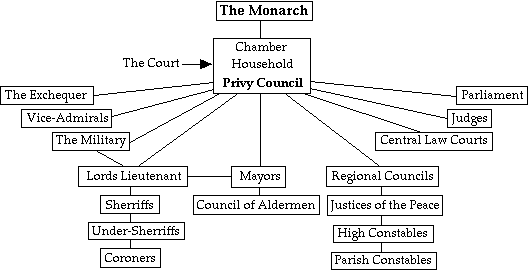The heirarchy of the Elizabethan Court
The Elizabethan administrative structure was highly centralized, with most actions centred on the Privy Council, which in turn was directly appointed by the monarch.
Click on the diagram to learn of the duties of each sector of the administration.
Heirarchies within society are discussed in the section on the history of ideas.
Footnotes
-
The Monarch
The Queen held supreme power according to law, heredity and the doctrine of divine right; she was the primary source of patronage and had the last word on all state policy. Government was viewed as the monarch's private business and its success therefore depended greatly upon the ruler's strength of character and political acumen.
Elizabeth was particularly successful because she valued the goodwill of her subjects above all; the abuse of royal prerogative under James and Charles I provoked much resentment and led to increasing limitations upon royal power.
-
The Chamber
The domestic servants of the monarch, living in close quarters with the Queen (or King) at Court. The 40 messengers of the Chamber were also used by the Privy Council to make arrests.
-
The Household
Servants of the monarch who attended to the public face of Court administration; the Court merged with central government since servants of the Household and Chamber often held offices in the Privy Council and state bureacracy.
-
Vice Admirals
Overseers of coastal counties or of seaboard areas within a county. Though appointed by the Admiralty they were instructed by the Privy Council as were the Lords Lieutenant and Judges.
-
The Exchequer
The centre of Crown finance; the Lord Treasurer, a leading member of the Privy Council, appointed officials to collect revenues from the counties. The revenue was then passed up through the various levels of administration from the Parish Constables.
Fraud and tax evasion inevitably diverted much government revenue, and no effective method was devised to resolve the problem largely because officials were insufficiently paid; even the scrupulous Lord Burghley was guilty of tax evasion while acting as Lord Treasurer.
-
The Lords Lieutenant
About thirty peers and privy councillors were appointed by the monarch to oversee the local administration of counties, usually in areas where they had estates or business interests of their own. They acted as a liaison between the military and local branches of government and were responsible for the division of the country into its administrative regions. they supervised the muster roll and summoning of soldiers, the provision of military supplies and storehouses, and the provision of local tax money to provide for the equipment and transportation of military troops. These officials were instructed by royal messengers and by visits to Court.
Deputy Lieutenants were assistants to the Lords Lieutenant. They were drawn from gentry and also appointed by the Crown; there were at least two deputies in each county.
-
Sherriffs and Under-Sherriffs
Though beneath the Lords Lieutenant, the Sheriffs remained the most direct representative of the Crown in the counties. They were appointed annually from among leading men of the counties, chosen by the monarch from a list of nominees compiled by privy councillors and judges. Among their duties were the collection of fines, keeping of the jails, some law enforcement, and the arranging of elections to Parliament (they ordered gentry or town burgesses under their jurisdiction to elect two representatives to the Commons--and often influenced the final choice).
They appointed their own deputies, or Under-Sheriffs.
-
The Coroner
The coroner (or "crowner") was elected from gentry below the rank of knight. There were from 1-6 per county, and they assisted with law enforcement and the assembling of juries. Their main responsibility (as today) was to determine the cause of death where circumstances were suspicious.
